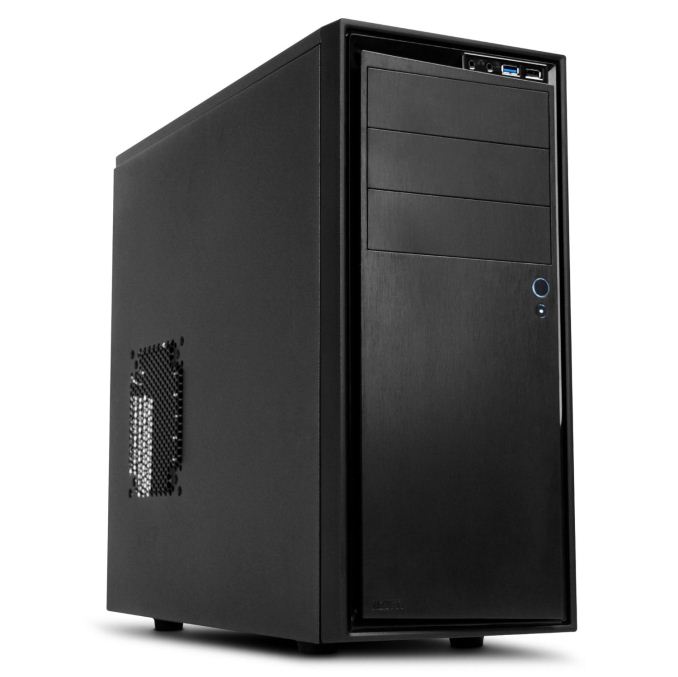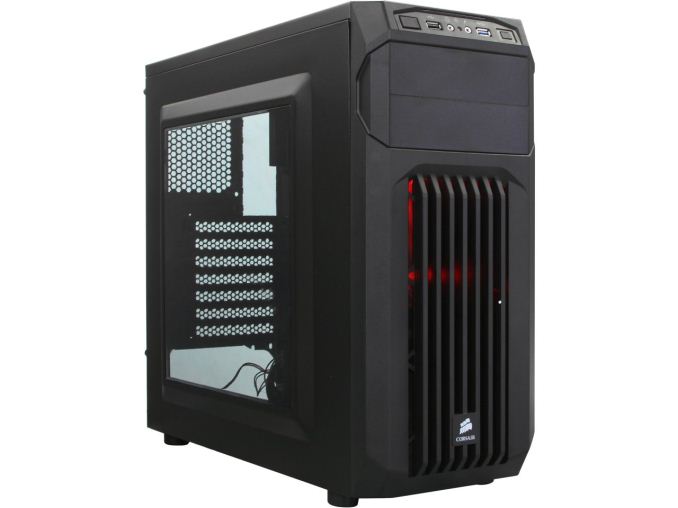Best PC You Can Build for Under $500
by Jarred Walton on August 1, 2014 11:11 AM EST
With yesterday's launch of AMD's 65W Kaveri APUs, it seemed a good time to give some recommendations for new system builds. We're starting out at the budget end of the spectrum, however, and pricing/availability on Kaveri generally rules it out. We'll keep things short and look at two builds, one AMD and one Intel. Outside of the CPU/APU and motherboard, parts are generally interchangeable.
| Budget AMD System | ||
| Component | Description | Price |
| CPU | AMD A6-6400K (2x3.9GHz, 1MB, 65W, 32nm) | $65 |
| Motherboard | MSI A88X-G41 | $73 |
| RAM | Team Vulcan 8GB (2x4GB) DDR3-2133 CL10 | $71 |
| Storage | Seagate Barracuda ST1000DM003 1TB | $55 |
| SSD | SanDisk Ultra Plus SDSSDHP-128G-G25 128GB | $60 |
| Case | NZXT Source 210 S210-001 | $40 |
| Power Supply | Seasonic SS-300ET 300W 80 Plus Bronze | $38 |
| Total (without OS) | $402 | |
The Kaveri APUs provide a decent blend of general and gaming performance, but finding one priced reasonably for a budget system is still a bit difficult (depending on your definition of budget, of course). While the idea of an inexpensive system capable of running games is fine, the cost to go from the A6-6400K we've selected to one of the Kaveri A10 models is more than the cost of a moderate dedicated graphics card like the R7 250, and the A6-7400K and A8-7600 are hard to find – and when you can find them, they're priced $15 higher than the MSRP. If you can wait a bit, the A6-7400K and A8-7600 should become more readily available. In the meantime, the A6-6400K will provide similar performance with a slightly slower graphics configuration.
 For the rest of the system, the MSI motherboard can support both existing Richland APUs like the A6-6400K we've selected as well as Kaveri APUs. Similarly, the DDR3-2133 RAM can provide better bandwidth than DDR3-1600 RAM that would only save you a buck. For storage, you've got three options: go pure SSD and have fast storage performance but without a lot of capacity, buy the 1TB HDD and sacrifice performance for capacity, or get both. Personally, I'd go with a pure SSD or the SSD+HDD configuration.
For the rest of the system, the MSI motherboard can support both existing Richland APUs like the A6-6400K we've selected as well as Kaveri APUs. Similarly, the DDR3-2133 RAM can provide better bandwidth than DDR3-1600 RAM that would only save you a buck. For storage, you've got three options: go pure SSD and have fast storage performance but without a lot of capacity, buy the 1TB HDD and sacrifice performance for capacity, or get both. Personally, I'd go with a pure SSD or the SSD+HDD configuration.
Wrapping things up, the case is a decent looking and not too expensive NZXT Source 210. Cases can be a very subjective topic, and there are plenty of reasonable options, but the NZXT is a good choice for a budget build. You could also drop down to a micro-ATX case and motherboard, and if that's what you're after the MSI A78M-E45 would be a good alternative. For the power supply, the small increase in efficiency offered by 80 Plus Gold isn't really worth the added cost at this price, and Seasonic makes a good 300W unit that will provide good efficiency for a low-power system like this while still allowing for the use of a moderate discrete GPU down the road should you choose to upgrade.
| Budget Intel System | ||
| Component | Description | Price |
| CPU | Celeron G1850 (2x2.9GHz, 2MB, 53W, 22nm) | $50 |
| Motherboard | Gigabyte GA-H97M-D3H | $80 |
| RAM | Team Vulcan 8GB (2x4GB) DDR3-1600 CL9 | $70 |
| Storage | Seagate Barracuda ST1000DM003 1TB | $55 |
| SSD | SanDisk Ultra Plus SDSSDHP-128G-G25 128GB | $60 |
| Case | Corsair Carbide Series SPEC-01 | $50 |
| Power Supply | Seasonic SS-300ET 300W 80 Plus Bronze | $38 |
| Total (without OS) | $403 | |
The Intel budget build is going to provide a pretty similar experience to the AMD build overall; single-threaded performance will be a bit higher, but graphics performance will be lower. The price for these two builds is equivalent at around $400 – which includes both a 128GB SSD and a 1TB HDD, so you can shave off $50 by dropping one or the other storage option. The Celeron G1850 is Intel's least expensive Haswell option right now, and while budget CPUs aren't going to win in any performance contests, for normal tasks they're still plenty fast. Paired with a 128GB SSD they can make for a decent home/office system and the price is certainly appealing. Overclocking isn't really a goal of either of these builds, and Gigabyte's GA-H97M-D3H should do fine for stock clocks.
 The one other noteworthy change is that we've included a slightly more expensive (and perhaps a bit too gaudy for some) Corsair Carbide SPEC-01 case. It has lots of angles and vents, and while Corsair has made some very good cases opinions on aesthetics are still up for debate. It ships with two 120mm fans for cooling, which is going to be overkill for a budget build like this but will give you room to grow. It also has a case window and red LED lighting for those that want to show off a bit.
The one other noteworthy change is that we've included a slightly more expensive (and perhaps a bit too gaudy for some) Corsair Carbide SPEC-01 case. It has lots of angles and vents, and while Corsair has made some very good cases opinions on aesthetics are still up for debate. It ships with two 120mm fans for cooling, which is going to be overkill for a budget build like this but will give you room to grow. It also has a case window and red LED lighting for those that want to show off a bit.
Of course we're still missing the OS, keyboard, mouse, and display; these are all commodity items and most people have existing accessories they can carry over from an old PC. Unless you're running a free OS like Ubuntu or some other flavor of Linux, the cost of Windows is going to represent a significant increase in price of nearly $100, putting us at the $500 mark referenced in the title. Adding a 20" to 22" LCD will tack on another $100-$140, and a keyboard and mouse will be $25 combined for a basic set. So all told if you want a complete new PC the price will be closer to $650, but $500 for the core system and software is a good starting point. You can also find some mail-in rebates on quite a few parts that might drop the price a bit, but as those change regularly I haven't included any in the above tables.










85 Comments
View All Comments
HangFire - Saturday, August 2, 2014 - link
I avoid Thermaltake because I had one and after 3 years it blew and took out my 1 year old motherboard. I'm sure it's possible to make a good power supply that's not 80+ rated; but it's much harder to make one that is rated and is bad.FITCamaro - Friday, August 1, 2014 - link
Drop the SSD and get a better CPU. In a budget system you can wait a few extra seconds for things to load. I'd rather have more processing power or a dedicated GPU.kyuu - Friday, August 1, 2014 - link
I have to disagree. The SSD is going to make a bigger difference in general usage than a slightly better CPU. If you want to game somewhat seriously then of course a dedicated GPU would make sense, but then this isn't specifically about gaming. And I still wouldn't recommend even a budget gaming build that depends on a spinning disk nowadays when you can get a 128GB SSD for 60 bucks.Beany2013 - Sunday, August 3, 2014 - link
Kyuu is correct.A Core2Duo at 2ghz with an SSD will walk all over a midrange i3/low end i5 with a normal HDD in all the metrics that matter - boot time, application load, OS response, application switching, etc. The only place it slows down is CPU intensive stuff, but you've saved that time *everywhere else*.
I've got a 2008 Macbook with an SSD and it's quicker than pretty much anything with a HDD in it - and it's six years old. It regularly runs three or four browsers (all for different tasks), two Mail accounts, each with 1000's of emails each, a database client, a few terminals, and a freaking Windows 7 VM without a hiccup. With the old HDD in it that was an exercise in patience. That workload is never going to be super-zippy on a Core2, but the performance is perfectly adequate in every respect when you give it an SSD to run on.
SSDs are so cheap now that if you have a system based around Core architecture (anything from Core2 or it's AMD equivalent) then swapping out the boot drive for an SSD will make it feel like a new machine, and will give you more of a difference than swapping the guts out for something quicker/newer in most cases (unless you only chase benchmark results, natch). And even if it makes little difference (highly unlikely) you can add the SSD to your new mobo/cpu/RAM and have something stonkingly quick.
It's not just waiting a few seconds for something to load - it's a few hundredths of a second for *everything* to respond, every time you have a disk hit. And if you look at how many disk hits a modern OS has over the course of it's working day, you'll quickly work out why that matters.
Peroxyde - Friday, August 1, 2014 - link
Dear experts,Can you please advise me the CPU to build a NAS server? I have already most of the parts, the only thing missing is CPU (must be x86 64 bits) & Mobo (must have SATAs, non-ECC DDR3). The most important criteria for me is low consumption, low noise, good quality parts.
The goal is mainly to have fun and learn to build myself a NAS server. Thinking of NAS4Free or OpenMediaVault. But have no idea. If you have experience building your own linux NAS server, I would also appreciate some guidances too.
Thanks in advance.
britjh22 - Friday, August 1, 2014 - link
I have a very basic FreeNas build I am currently running on an old AM3 Athlon X3 setup, seems to be plenty. Are you just using it for storage/remote access, or are you using Plex or the like, that seems to be the biggest determinant for how much CPU power you need.Peroxyde - Friday, August 1, 2014 - link
Hi,Main goal is a file server. Occasionally browsing the web and playing some videos as the server sits in front of the TV. Never used Plex Server, I probably don't need it. It would be easy for me to buy an i3 or i5, but for the challenge, I'd like something low energy and yet still fulfill the job.
Daniel Egger - Friday, August 1, 2014 - link
You will definitely want something *with* ECC for your NAS. There're several options but if you want to have lowest possible power consumption there's something like the Intel Xeon E3-1230L v3 and of course Intel C chipset.If you really don't care then just get whatever flies of the shelf cheapest in terms of consumer technologies and get some RAID controller instead, however that takes the possibility of running a BSD based NAS with ZFS because then the RAID controller will be mostly useless...
Hrel - Friday, August 1, 2014 - link
That's a pretty far cry from "the best you can do under $500. This leaves so many more upgrade options, you could put in an R7 265 or 270x with this PSU and case. Which wouldn't be bottlenecked by the CPU since I didn't use a fucking Celeron. If you own an external hdd or use a NAS you can ditch the internal mechanical disk and save money or upgrade something else.Your choice of CPU, memory, PSU and especially SSD are truly troubling. For $40 more I doubled your SSD capacity, gave you something twice as fast with twice as high an MTBF. Seriously, did you even try?
[PCPartPicker part list](http://pcpartpicker.com/p/QxxXJx) / [Price breakdown by merchant](http://pcpartpicker.com/p/QxxXJx/by_merchant/)
Type|Item|Price
:----|:----|:----
**CPU** | [Intel Core i3-4150 3.5GHz Dual-Core Processor](http://pcpartpicker.com/part/intel-cpu-bx80646i341... | $117.00 @ Newegg
**Motherboard** | [MSI H81M-E33 Micro ATX LGA1150 Motherboard](http://pcpartpicker.com/part/msi-motherboard-h81me... | $44.99 @ Micro Center
**Memory** | [Crucial Ballistix 8GB (1 x 8GB) DDR3-1866 Memory](http://pcpartpicker.com/part/crucial-memory-blt8g3... | $79.99 @ Newegg
**Storage** | [Mushkin Chronos 240GB 2.5" Solid State Drive](http://pcpartpicker.com/part/mushkin-internal-hard... | $99.99 @ Newegg
**Storage** | [Western Digital WD Green 2TB 3.5" 5400RPM Internal Hard Drive](http://pcpartpicker.com/part/western-digital-inter... | $81.69 @ Amazon
**Case** | [Fractal Design Core 1000 USB 3.0 MicroATX Mid Tower Case](http://pcpartpicker.com/part/fractal-design-case-f... | $19.99 @ Newegg
**Power Supply** | [Corsair CX 430W 80+ Bronze Certified Semi-Modular ATX Power Supply](http://pcpartpicker.com/part/corsair-power-supply-... | $24.99 @ Newegg
| | **Total**
| Prices include shipping, taxes, and discounts when available | $468.64
| Generated by PCPartPicker 2014-08-01 17:48 EDT-0400 |
iLovefloss - Saturday, August 2, 2014 - link
One thing you got to remember is that AnandTech only use NewEgg for prices, and they specifically choose not to include prices after rebate (except for the Carbide which they did to artificially inflate the price of the Intel build/a Pentium would've been a better choice).If you ignore rebates (since you can't be sure you'd get them) and promos (which may be over when you decide to buy) while only using NewEgg, your build would be around $535 USD. If you keep the rebates, your build would be $500. Now, your build is definitely better, but you'd be paying almost $100 more for it. That's a huge increase that won't matter to someone just looking for a budget computer that can do all kinds of things (and maybe game on the side).
You could still get around to AnandTech's build's price if you drop the SSD and HDD down to ~120GB and 1TB respectively if you include rebates. If you're not including rebates, you could opt for a Pentium-K instead or buy an equivalent AMD APU/motherboard setup.